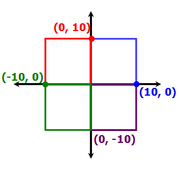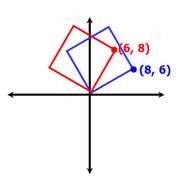A certain square is to be drawn on a coordinate plane. One of the vertices must be on the origin, and the square is to have an area of 100. If all coordinates of the vertices must be integers, how many different ways can this square be drawn?
(A) 4
(B) 6
(C) 8
(D) 10
(E) 12
Coordinate geometry
This topic has expert replies
GMAT/MBA Expert
- [email protected]
- Elite Legendary Member
- Posts: 10392
- Joined: Sun Jun 23, 2013 6:38 pm
- Location: Palo Alto, CA
- Thanked: 2867 times
- Followed by:511 members
- GMAT Score:800
Hi RiyaR,
This question shows up every once in a while, but you can absolutely solve it IF you're willing to "play around" a bit with a drawing. As such, I'm going to give you some hints so that you can try to solve it on your own:
1) The square has to be 10x10. Can you draw a 10x10 square on a graph with one corner at the Origin (0,0)? How many obvious ones can you come up with (hint: the smallest answer choice is 4, so there have to be AT LEAST 4 possible squares).
2) Once you have drawn the obvious squares, are there any other squares that you could draw (hint: squares DO NOT necessarily have to be parallel with the X- and Y-axes)?
3) Since we're dealing with a graph, there are likely to be "mirror images" of any shape that you draw....
GMAT assassins aren't born, they're made,
Rich
This question shows up every once in a while, but you can absolutely solve it IF you're willing to "play around" a bit with a drawing. As such, I'm going to give you some hints so that you can try to solve it on your own:
1) The square has to be 10x10. Can you draw a 10x10 square on a graph with one corner at the Origin (0,0)? How many obvious ones can you come up with (hint: the smallest answer choice is 4, so there have to be AT LEAST 4 possible squares).
2) Once you have drawn the obvious squares, are there any other squares that you could draw (hint: squares DO NOT necessarily have to be parallel with the X- and Y-axes)?
3) Since we're dealing with a graph, there are likely to be "mirror images" of any shape that you draw....
GMAT assassins aren't born, they're made,
Rich
GMAT/MBA Expert
- Brent@GMATPrepNow
- GMAT Instructor
- Posts: 16207
- Joined: Mon Dec 08, 2008 6:26 pm
- Location: Vancouver, BC
- Thanked: 5254 times
- Followed by:1268 members
- GMAT Score:770
Since the square's area is 100, each side must have length 10.RiyaR wrote:A certain square is to be drawn on a coordinate plane. One of the vertices must be on the origin, and the square is to have an area of 100. If all coordinates of the vertices must be integers, how many different ways can this square be drawn?
(A) 4
(B) 6
(C) 8
(D) 10
(E) 12
If all coordinates of the vertices must be integers, we might immediately see that these 4 squares all meet the given conditions:

Any others?
You bet.
At this point, we're looking for something called Pythagorean Triplets. These are sets of three INTEGER values that could be the 3 sides of a right triangle.
The two most common ones to remember for the GMAT are 3-4-5 and 5-12-13.
We should also look out for MULTIPLES of these, such as 6-8-10 and 50-120-130
For this question, the 6-8-10 triplet comes into play. So, the hypotenuse (with length 10) will be one side of the square and the 6 and 8 will be the coordinated of the vertex.
Here are 2 such squares in Quadrant I:

As you might guess, there will be 2 of these types of squares possible in each of the 4 quadrants for a total of 8 squares.
So, the TOTAL number of squares = 4 + 8 = 12
Cheers,
Brent
-
RiyaR
- Senior | Next Rank: 100 Posts
- Posts: 98
- Joined: Sat May 31, 2014 8:29 pm
- Thanked: 1 times
- Followed by:2 members
I got the part about 4 and een the mirror images....but Im not convinced as to how the answer will strike? What do you when there is a modification of the same question? Will the pythagoran triplets apply?
GMAT/MBA Expert
- [email protected]
- Elite Legendary Member
- Posts: 10392
- Joined: Sun Jun 23, 2013 6:38 pm
- Location: Palo Alto, CA
- Thanked: 2867 times
- Followed by:511 members
- GMAT Score:800
Hi RiyaR,
YES, since we're dealing with a square that has a side length of 10, we ARE dealing with a Pythagorean triple (the 3/4/5; more specifically a 6/8/10, which is the 3/4/5 "doubled"). Spotting this pattern is the key to solving this problem in an efficient manner.
It's important to remember that ANY time you draw a diagonal line on a graph, you have the hypotenuse of a right triangle. As such, you can use the Pythagorean Formula and possibly the common Pythagorean triples.
GMAT assassins aren't born, they're made,
Rich
YES, since we're dealing with a square that has a side length of 10, we ARE dealing with a Pythagorean triple (the 3/4/5; more specifically a 6/8/10, which is the 3/4/5 "doubled"). Spotting this pattern is the key to solving this problem in an efficient manner.
It's important to remember that ANY time you draw a diagonal line on a graph, you have the hypotenuse of a right triangle. As such, you can use the Pythagorean Formula and possibly the common Pythagorean triples.
GMAT assassins aren't born, they're made,
Rich





















